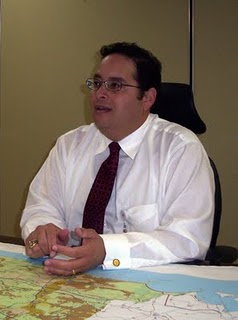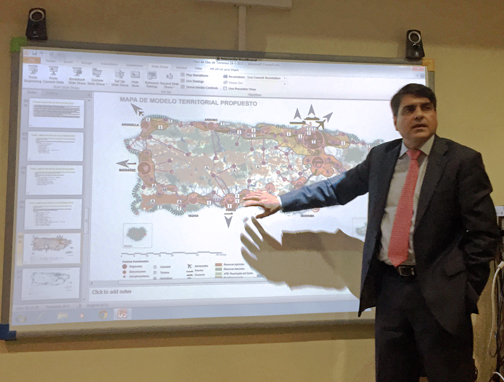Planning Board chief: Land use plan will be ready in ’12

He is an urban planner who lives on a five-acre farm in rural Vega Baja with his wife and a bunch of animals. But make no mistake about it, Ruben Flores Marzán, who was named Puerto Rico Planning Board president less than a month ago, is not horsing around when it comes to development.
He is intent, however, on making that happen in a sustainable way under his belief that it should lead to a “better environment, better economy, and better quality of life.”
In his first interview with members of the local media, the 43-year-old public servant said the most important target on his radar is releasing the much-delayed land use plan in 2012, and working with the government to trace the route toward adopting sustainable energy and sound planning practices.
The land use plan, which was mandated by law in 2004, seeks to finally define which land can and cannot be used for development, to somehow address the seemingly unstoppable wave of urban sprawl and protect the island’s natural resources. The land use plan is expected to identify flood-prone areas, farmlands and cultural sites.
The approval process has been plagued by delays as mayors, environmentalists and developers have expressed criticism to the preliminary proposals that have surfaced over the last seven years.
“A key element in my administration is publishing that land use plan,” said Flores Marzán, who has a bachelor’s degree in geography from the University of Puerto Rico and two master’s degrees from the University of Akron in Ohio in urban planning and urban geography.
“I’m highly interested in the fact that planning is moving toward addressing issues that are on a regional scale, which in turn addresses many of the problems that we have here — unemployment, crime, environmental degradation — that municipalities cannot fix on their own,” he noted.
The land use plan’s current focus is to address several issues in an integrated manner, Flores Marzán noted. First, it must define which areas of the urban and natural footprints can be developed, particularly defining those sites that can serve recreational and tourism-related purposes.
Second, the plan to be released sometime next year also contemplates the issue of regionalization. It will also consider an element of master planning, through which the agency will outline alternatives to foster improved quality of life, he noted.
Ultimately, the land use plan will provide the flexibility to accommodate changing needs and the element of design, which Flores Marzán said deserves consideration.
“We’re going to harmonize the land use plan with what’s in place at the municipalities and collaborate to see what the issues are,” he said. “We also have to give design a chance, so we’re going to be basing much of what we do on physical planning that is friendly, conducive to walking and that reduces the jobs-to-housing ratio, because we’re spending 45 percent of our household income on housing and transportation costs, and that’s unsustainable.”
Ultimately, the goal is to achieve a balance between what the government is looking to do and what citizens want and need, he noted.
“We need to find a balance through dialogue and a process of public participation during which we can provide the most information possible and meet with communities to see what is viable to do,” he said. “Utopias do not interest us, but rather the things we can do that will result in the best interest of all parties.”
Planning for the 21st century
In that pursuit of laying down the groundwork for organized development, aspects such as agriculture and environmental friendliness must take center stage, he said.
“I bring to the table my professional capacities and common sense that says that if we have a large portion of land that is available for farming, and people need to eat and we need to have food security, then we need to create the conditions for a rebirth in farming,” said Flores Marzán, marking the first time in a considerable number of years since the Planning Board has placed emphasis on agriculture, which has been losing considerable ground on the island over the last two decades.
He said stressing the need for agricultural growth addresses one of several crises of the 21st century, which is witnessing limited economic, energetic and natural resources.
“One of those main problems is having enough food to feed our people, and as an island we need to have the capacity to sustain ourselves and generate our own food,” he noted.
On the issue of transportation, Flores Marzán highlighted the need for a regional system that encompasses the Urban Train with interconnecting municipal services, such as existing trolleys and future light rail systems planned for towns such as San Juan and Caguas.
Defending Vía Verde
Unsurprisingly, Flores Marzán believes the controversial Vía Verde natural gas pipeline project championed by the Gov. Luis Fortuño administration is the right way to go to start diversifying the island’s energy sources, another top-of-mind issue for him. The project is part of the government’s energy reform platform that seeks to reduce energy costs while cutting back on carbon emissions by 64 percent.
“We have to have a will to develop renewable energy projects, which lead to solving environmental health problems. If we have less fossil fuel spilling into our water bodies, we will achieve better air and water quality, as well as preserve the integrity of our lands,” Flores Marzán argued.
The $450 million Vía Verde project has met with much objection from environmental and grassroots organizations that claim it will damage natural ecosystems along the construction route. Thousands gathered Sunday in Adjuntas to march against the project that culminated in a people’s assembly during which they symbolically denied permission to the Puerto Rico Electric Power Authority’s proposal.
The group headed by nonprofit organization Casa Pueblo also vowed civil disobedience if the government moves forward with building the 91-mile long pipeline that would run north from Peñuelas to Arecibo, and east to San Juan.
“The island and the nation are being held hostage by petroleum, so we need to move toward using natural gas, establishing solar and wind farms on the island, and even consider offshore alternatives,” he noted, admitting that moving toward what has been unchartered territory is stressful, especially if education on the subject is still lacking.
“This is about education, it’s about telling people not to be fearful of the future and what the proposed changes represent for public health,” he said. “Vía Verde is good for the environment, it reduces energy costs, which leads to a better quality of life because in the end, people will have more money available to do other things.”









